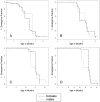Evidence of Early Emergence of the Primary Dentition in a Northern Plains American Indian Population
- PMID: 29568802
- PMCID: PMC5858651
- DOI: 10.1177/2380084418756054
Evidence of Early Emergence of the Primary Dentition in a Northern Plains American Indian Population
Abstract
The purposes of this study were to describe primary tooth emergence in an American Indian (AI) population during the first 36 mo of life to compare 1) patterns of emergence between male and female children and 2) tooth emergence between these AI children and other U.S. ethnic groups. Data were derived from a birth cohort of 239 AI children from a Northern Plains tribe participating in a longitudinal study of early childhood caries, with examination data at target ages of 8, 12, 16, 22, 28, and 36 mo of age (±1 mo). Patterns of emergence in AI children were characterized and sex comparisons accomplished with interval-censored survival methodology. Numbers of erupted teeth in AI children at each age were compared via Kruskal-Wallis tests against those in children of the same age, as drawn from a cross-sectional study of dental caries patterns in Arizona; these comparisons were based on the dental examinations of 547 White non-Hispanic and 677 Hispanic children. Characterization of time to achievement of various milestones-including emergence of the anterior teeth, the first molars, and the complete primary dentition-provided no evidence of sex differences among AI children. AI children had significantly more teeth present at 8 mo (median, 3) than either White non-Hispanic (P < 0.0063) or Hispanic (P < 0.0001) children (median, 2 each). This was also true at 12 mo (P < 0.001; medians, 8 vs. 6 and 7, respectively) and 16 mo (P < 0.001; medians, 12 vs. 11 each). Less pronounced differences were seen at 22 mo (P < 0.0001). White non-Hispanic and Hispanic children did not differ at any time considered (P > 0.05). These results provide evidence of earlier tooth emergence in AI children than in the other 2 ethnicities. Although the underlying etiology of the severity of early childhood caries in AI children is likely to be multifactorial, earlier tooth emergence may be a contributing factor. Knowledge Transfer Statement: The findings of this study have practical implications for practitioners providing childhood oral health care to ethnic groups with early tooth emergence. It may be important to provide parents with information on toothbrushing, dentist visits, and other practices supportive of good oral health as early as possible to protect their children's primary dentition.
Keywords: children; dental caries; minority health; oral health disparities; tooth emergence; tooth eruption.
Conflict of interest statement
The authors declare no potential conflicts of interest with respect to the authorship and/or publication of this article.
Figures


References
-
- Adler D. 2005. Violin plot, R package “vioplot” [accessed 2018. Jan 9]. http://cran.r-project.org/web/packages/vioplot/vioplot.pdf.
-
- Berkowitz RJ. 2006. Mutans streptococci: acquisition and transmission. Pediatr Dent. 28(2):106–109. - PubMed
-
- Bezerra DS, Stipp RN, Neves BG, Guedes SF, Nascimento MM, Rodrigues LK. 2016. Insights into the virulence traits of Streptococcus mutans in dentine carious lesions of children with early childhood caries. Caries Res. 50(3):279–287. - PubMed
-
- Centers for Disease Control and Prevention. 1985. Dental caries in American Indian and Alaska native children. MMWR Morb Mortal Wkly Rep. 34(26):400–401. - PubMed
Grants and funding
LinkOut - more resources
Full Text Sources
Other Literature Sources

